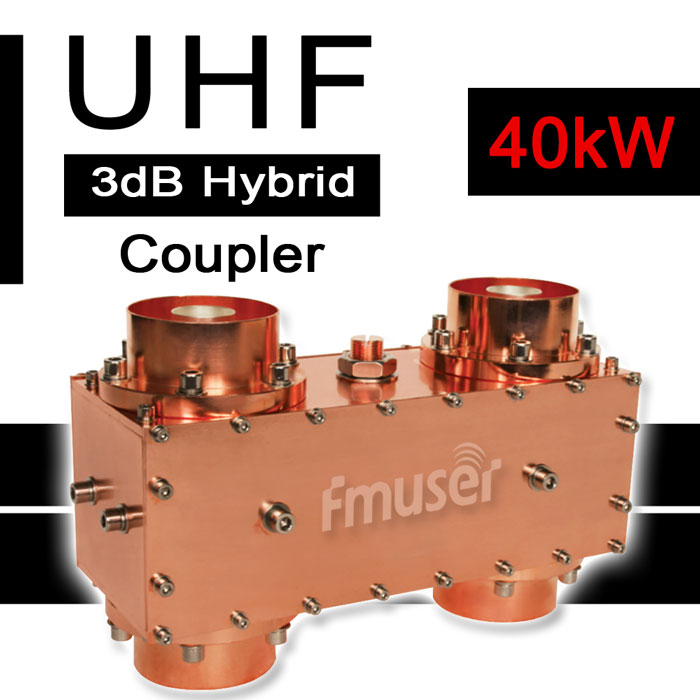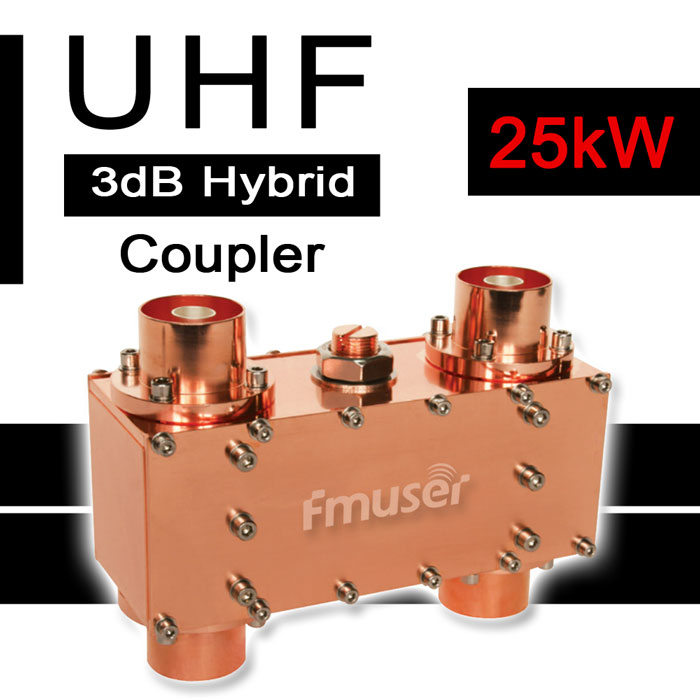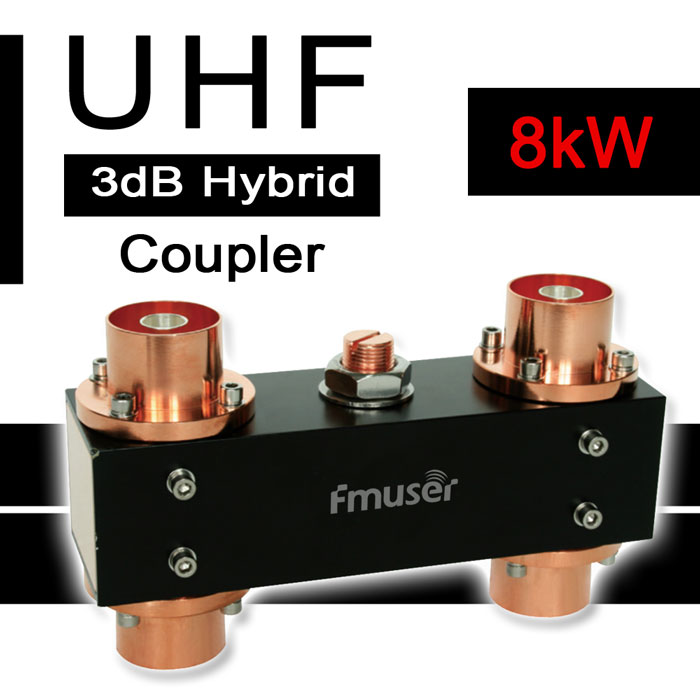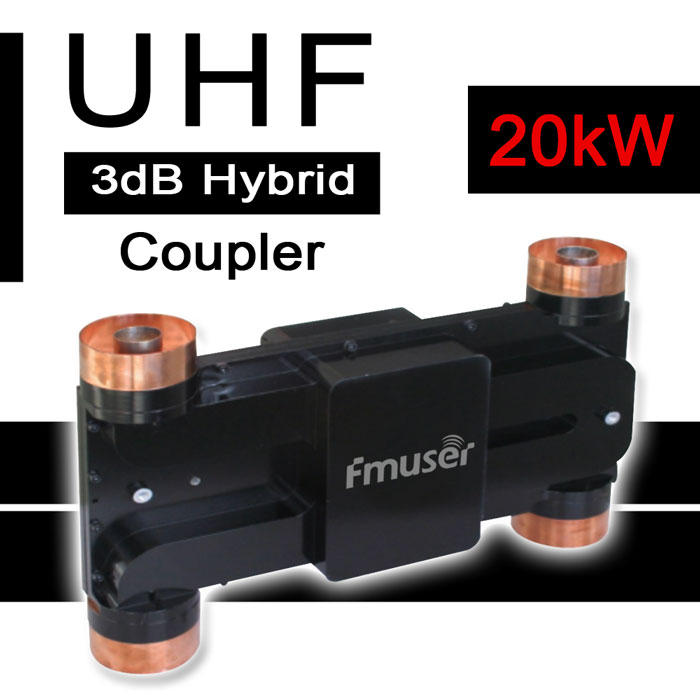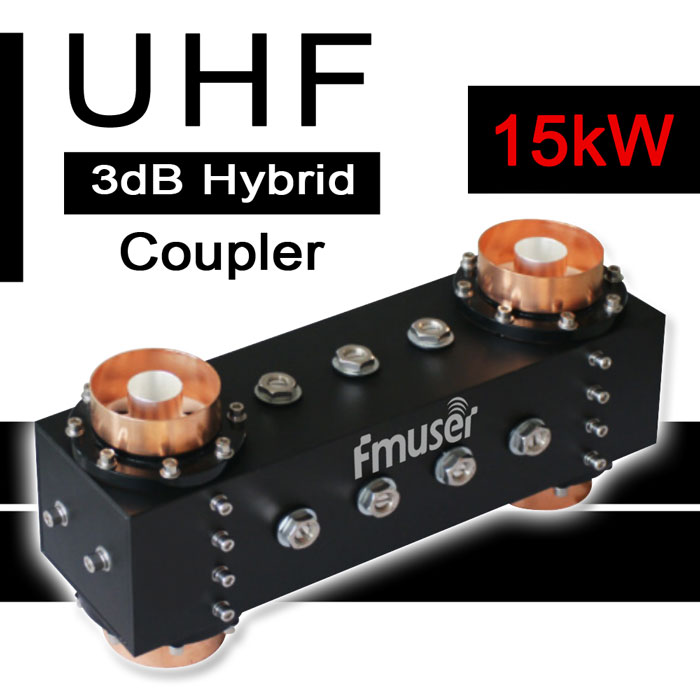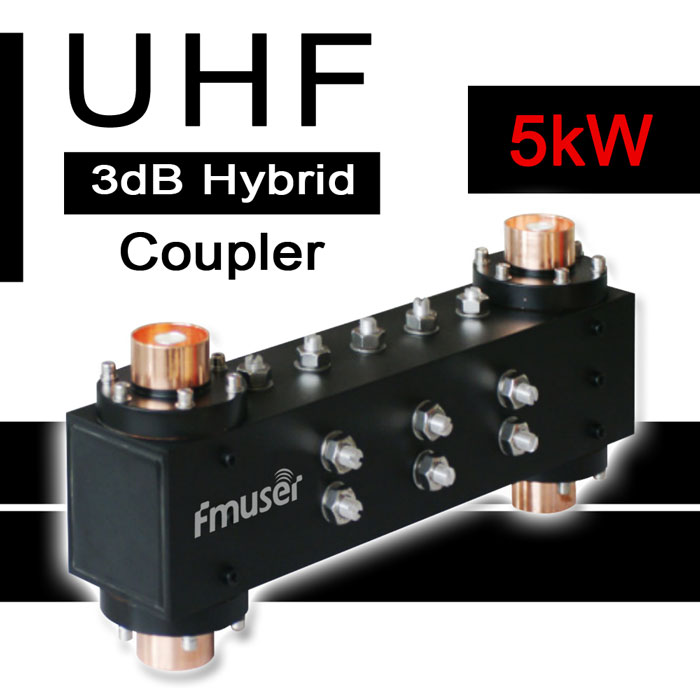
UHF Couplers
1. Revolutionizing RF Efficiency: FMUSER’s Advanced UHF Hybrid Couplers
FMUSER’s UHF Hybrid Coupler solutions are cornerstone components in modern radio frequency (RF) systems, expertly addressing signal management challenges in telecommunications, broadcasting, and wireless infrastructure. Specializing in high-performance RF components, FMUSER categorizes its couplers based on frequency range, power handling capacity, and application-specific designs, streamlining selection for professionals seeking robust solutions for signal splitting, combining, or impedance matching. Whether optimizing 5G networks or broadcast towers, our couplers ensure seamless integration for mission-critical projects.
2. Engineered Excellence: Powering Your RF Systems
- Wide Frequency Compatibility: Operate flawlessly across UHF bands (300 MHz–3 GHz), ideal for diverse RF setups.
- Industrial-Grade Durability: Built to withstand harsh environments with superior heat dissipation and corrosion resistance.
- Ultra-Low Insertion Loss & High Isolation: Minimize signal degradation while maximizing output clarity.
- Scalable Solutions: From compact, entry-level couplers for labs to high-power models for broadcast towers, FMUSER caters to engineers, integrators, and enterprises alike.
- Certified Reliability: CE/FCC-compliant designs ensure compliance with global standards.
3. Unleashing Innovation: Where FMUSER’s Solutions Excel
- 📡 Broadcasting: Split and distribute high-power signals across antennas without loss. Benefit: FMUSER’s couplers ensure 24/7 reliability for TV/radio stations.
- 📶 Telecom Networks: Combine multiple signals in 5G/LTE base stations. Benefit: High isolation prevents interference, boosting network efficiency.
- 🛰 Military/Avionics: Transfer energy between RF circuits with precision. Benefit: Ruggedized designs meet MIL-STD specs for critical operations.
- 📻 Wireless IoT Systems: Match impedance between devices for seamless connectivity. Benefit: Compact models enable cost-effective scalability.
4. Why FMUSER? Turn RF Challenges into Opportunities!
- Factory-Direct Pricing: Cut costs with no middlemen.
- Always In Stock, Shipped Globally in 3 Days: Minimize downtime with rapid delivery.
- Turnkey Solutions: Pre-configured couplers, on-site installation support, and OEM customization.
- Proven Expertise: Trusted by broadcasters, telecom giants, and defense contractors worldwide.
5. Smart Buying Guide: Select the Perfect Coupler for Your Project
- Technical Specs: Prioritize frequency range (e.g., 450–950 MHz) and power handling (10W–10KW).
- Compatibility: Check connector types (N-Type, SMA) and impedance requirements.
- Budget-Friendly Options: FMUSER offers cost-effective models without compromising quality.
Still unsure? Contact our engineers for a free consultation to align your project goals with the ideal coupler!
-
![470-862 MHz 40kW 4 1/2" UHF Stripline 3dB Hybrid Coupler High Power RF Coupler Compact RF Divider Combiner for TV Broadcasting]()
Price(USD):Ask for a quotation
Sold:34
-
![470-862 MHz 25kW 3 1/8" UHF Stripline 3dB Hybrid Coupler TX RX RF Power Coupler High Power RF Splitter Combiner for TV Station]()
Price(USD):Ask for a quotation
Sold:34
-
![470-862 MHz 8kW 1 5/8" UHF 3dB Hybrid Coupler High Power RF Splitter 4 Port RF Divider Combiner UHF Power Divider for TV Station]()
Price(USD):Ask for a quotation
Sold:34
-
![470-862 MHz 20kW 1 5/8" 3db Hybrid Coupler Stripline RF Splitter TX UHF Hybrid Power Combiner UHF Power Divider for TV Station]()
Price(USD):Ask for a quotation
Sold:34
-
![470-862 MHz 15kW 1 5/8" 3dB UHF Wideband Coupler Compact 3db Hybrid Coupler TX Stripline Hybrid Splitter Combiner for TV Station]()
Price(USD):Ask for a quotation
Sold:34
-
![470-862 MHz 5kW 1 5/8" 3dB UHF Broadband Coupler Wideband Hybrid Coupler High Power Stripline Power Divider for FM Broadcasting]()
Price(USD):Ask for a quotation
Sold:34
- What is an UHF hybrid coupler, and what is its synonym?
- An UHF hybrid coupler is a device used in radio frequency systems to combine or split signals. It is also known as a hybrid tee, a quadrature coupler, or a Hy-Tee.
- How do you use an UHF hybrid coupler for broadcasting?
- Steps to correctly use an UHF hybrid coupler in broadcast station:
1. Connect the input port of the coupler to the transmitter.
2. Connect the output port of the coupler to the antenna system.
3. Connect the monitor port of the coupler to a spectrum analyzer or other monitoring device.
4. Tune the coupler to the desired frequency.
5. Adjust the coupler’s output power to the desired level.
6. Monitor the output power and make necessary adjustments.
7. Monitor the system for any interference and address any issues that arise.
Problems to avoid:
1. Antenna mismatch which can cause signal loss or distortion.
2. Insufficient power which can cause signal dropouts.
3. Excessive power which can cause interference to other services.
4. Poor monitoring which can cause signal quality issues.
5. Poor system maintenance which can cause long-term issues.
- How does an UHF hybrid coupler work?
- A UHF hybrid coupler is a device that is used in broadcast stations to combine and split signals. It works by combining the input signals from the transmitter onto the same transmission line, while also providing a path between the transmitter and the antenna. This allows the broadcast station to transmit one signal without interference, while still being able to receive signals from other sources. The hybrid coupler also ensures that the transmitter does not interfere with other signals that are present on the line.
- Why is an UHF hybrid coupler important for a radio station?
- A UHF hybrid coupler is important for broadcast stations because it allows them to split their signals into two separate antennas, allowing for greater signal coverage. This is especially important for stations with multiple transmitters in different locations. By using a UHF hybrid coupler, broadcasters can ensure that their signal reaches as far as possible without interference or distortion. Therefore, yes, a UHF hybrid coupler is necessary for a broadcast station.
- How many types of UHF hybrid couplers are there and what are the differences between them?
- There are three types of UHF hybrid couplers: 180 degree couplers, 90 degree couplers, and quadrature couplers. The main difference between them is the degree of the phase shift, which is 180 degrees for the 180 degree coupler, 90 degrees for the 90 degree coupler, and 45 degrees for the quadrature coupler. Additionally, the 180 degree coupler is used for splitting and combining signals, while the 90 degree and quadrature couplers are mainly used for combining and splitting signals.
- How do you choose the best UHF hybrid coupler?
- Before placing a final order, it is important to compare different UHF hybrid couplers based on their specifications, such as insertion loss, frequency range, isolation, return loss, power handling capacity, and size. Additionally, it is important to research the manufacturer to ensure that they have a good reputation and are known for producing reliable products.
- How do you correctly connect an UHF hybrid coupler into the broadcast system?
- To correctly connect a UHF hybrid coupler in a broadcast station, the following steps should be followed:
1. Connect the input port of the hybrid coupler to the transmitter's output port.
2. Connect the output port of the hybrid coupler to the antenna.
3. Connect the two remaining ports (A and B) to the two antenna lines. Make sure that the impedance of the two lines is matched correctly.
4. Check all connections and make sure that the hybrid coupler is working correctly.
5. Engage the hybrid coupler's bypass switch to complete the connection.
- What equipment is related to an UHF hybrid coupler?
- The equipment related to an UHF hybrid coupler in a broadcast station includes an RF combiner, directional couplers, RF switches, power dividers, and low-noise amplifiers. Additionally, antenna tuning units, antenna gain amplifiers, and antenna switches may also be used.
- What are the most important physical and RF specifications of an UHF hybrid coupler?
- The most important physical and RF specifications of an UHF hybrid coupler are insertion loss, directivity, isolation, return loss, frequency range, temperature range, power handling, VSWR, and impedance.
- How do you correctly maintain an UHF hybrid coupler as an engineer?
- To properly perform daily maintenance on a UHF hybrid coupler in a broadcast station, an engineer should do the following:
1. Check all connections to ensure they are secure and properly wired.
2. Test the signal levels to make sure they are within manufacturer specifications.
3. Monitor the temperature of the coupler to make sure it is at the optimal operating temperature.
4. Check for any signs of wear or damage that may have occurred over time.
5. Clean the coupler with a soft cloth to remove any dust or debris.
6. Test the coupler by sending predetermined signals through it to ensure proper operation.
7. Make any necessary adjustments to ensure the coupler is working correctly.
Following these steps should ensure that your UHF hybrid coupler is in proper working order and is ready to perform its designated tasks.
- How do you repair an UHF hybrid coupler if it is not working?
- To repair a UHF hybrid coupler, you should first identify the broken parts. Once you have identified the parts that are not working, you should then replace them with new parts. Depending on the type of hybrid coupler you have, you may need to purchase specific parts for it, such as connectors, cables, or other components.
Once you have the necessary parts, you should then follow the instructions that came with the coupler, or consult a professional for assistance. Depending on the complexity of the device, you may need to solder the new parts into place or use mechanical fasteners. Once the parts are installed, you should then power on the coupler and test it to ensure that it is working correctly.
- How do you choose the right packaging for an UHF hybrid coupler?
- When choosing the right packaging for an UHF hybrid coupler, it is important to ensure that the packaging is designed to protect the device from any damage during transportation. It should also be able to protect the device from any environmental changes such as temperature, moisture, and vibration. Pay attention to the packaging materials and the sealing method to make sure the device is securely packaged and won't be affected by external forces. Additionally, pay attention to the shipping method and make sure that it is suitable for the device.
- What material is used for the casing of an UHF hybrid coupler?
- The casing of an UHF hybrid coupler is generally made of metal, such as aluminum or stainless steel. These materials will not affect its performance, as long as it is properly insulated.
- What is the basic structure of an UHF hybrid coupler?
- A UHF (Ultra-High Frequency) hybrid coupler is composed of two four-port networks connected together. The four ports are the input, output, sum and difference ports. The input port receives the signal, the output port sends the signal, the sum port combines the two signals together, and the difference port subtracts the two signals from each other. The structure of the hybrid coupler determines the performance and attributes of the coupler. The four ports, the transmission lines and the junctions of the transmission lines make up the basic structure of the hybrid coupler. Without any of these structures, the coupler would not be able to function normally.
- Who should be assigned to operate an UHF hybrid coupler?
- The person who should be assigned to manage an UHF hybrid coupler in a broadcast station should ideally possess strong technical and electronics skills and experience. They should also have a sound understanding of the principles of radio broadcast transmission and the ability to troubleshoot any issues that may arise. Additionally, they should have excellent communication and problem-solving skills.
CONTACT US


FMUSER INTERNATIONAL GROUP LIMITED.
We are always providing our customers with reliable products and considerate services.
If you would like to keep touch with us directly, please go to contact us
